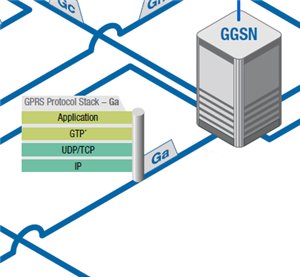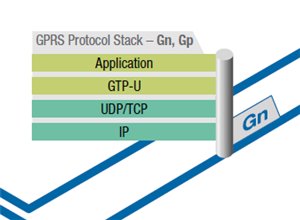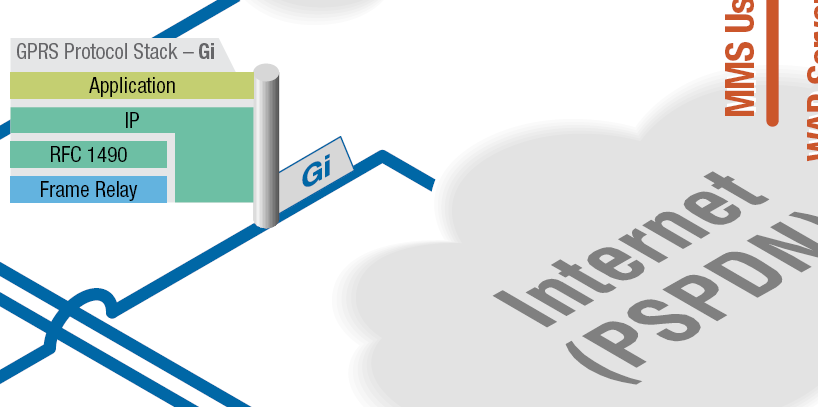GPRS inside. Part 3
In this article we continue our acquaintance with the structure and main functional elements of the mobile operator's packet network, which we started in the previous two articles - inside GPRS. Part 1 and GPRS from the inside. Part 2 . In our today's note we will discuss the main interfaces of the network elements of the PS Core Network, as well as the puncture stacks used on these interfaces.
The standard connection scheme of key GSN elements of a packet network, which is usually depicted in many textbooks and courses on the PS Core Network, looks like this:
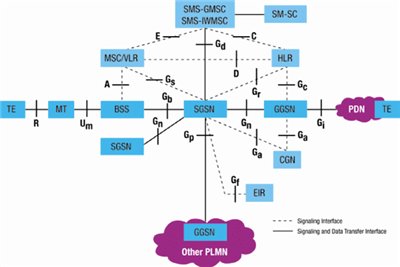
To begin with, I would like to clarify that not all of the interfaces shown in the figure above are necessary for the provision of package services to the end subscriber — some of them are optional, i.e. These interfaces introduce additional functionality for the core network elements of the PS Core Network, while others are the basis for building any packet network and will be implemented anyway.
')
It should also be remembered that some interfaces are intended only for transmission of service signaling information, therefore they are implemented on the basis of the SS7 model stack, and various technologies can serve as a transport for them - PCM , IP, ATM (see diagram below).

In principle, there is now a tendency to switch to IP-based communication channels on all interfaces of the packet network, which is associated with their economic benefits, high prevalence, as well as the TCP / IP network’s “nature” abroad of SGSN’s abroad and general transitions to similar IMS systems based on packet technologies.
In order to have a more holistic picture of all the interfaces and stacks of packet network protocols for 2G / 3G network architectures, we turn to the interface circuitry from Tektronix :
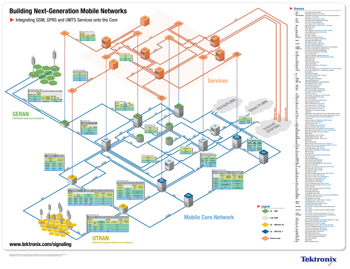
Based on this scheme, we begin our acquaintance with the interfaces of GSN elements.
Using this interface, the base station controllers are connected directly to the SGSN. And in fact, the channels on the base station controller (BSC) are organized on special boards - PCU [Packet Control Unit], which process the packet data of subscribers. The interface can be implemented both on a fairly common scheme via PCM lines ( E1 streams), the user data of which will be “packed” in Frame Relay (FR) connections to the SGSN, and directly on one of the packet technologies - IP, for example.
The overall protocol stack on this interface is shown in the diagram below:
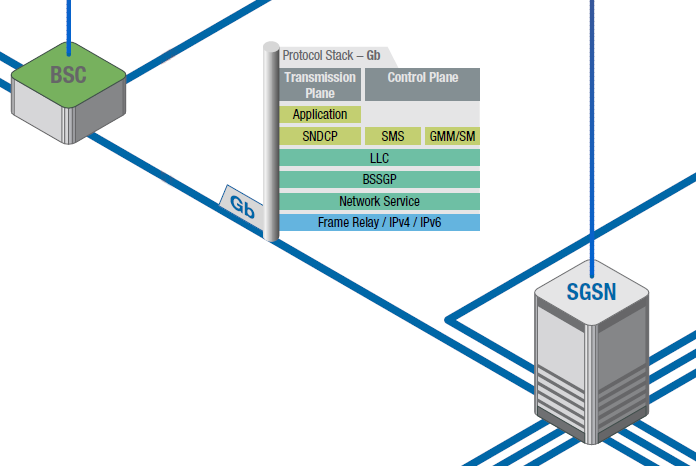
As we have already mentioned, recently there is a tendency to switch to more cost-effective and cheaper options for implementing network interfaces, so many vendors producing both base station controllers and SGSNs provide the ability to implement Gb interface based on IP transport, t . - Gb over IP.
At the same time, we should not forget that in the “pure” form of Gb the interface is implemented only for the 2G architecture, i.e. for the implementation of the interface between SGSN and the base station controller - BSC , and for 3G (UMTS), i.e. to implement the interface between the SGSN and the RNC (en) controller, the Iu-PS interface is used, and inside it there is a separation of signaling (control) planes - Control Plane (based on the GTP-C protocol) and subscriber data transfer planes - User Plane (based on GTP-U protocol).
The protocol stack of the Iu-PS interface is depicted in the diagram below:
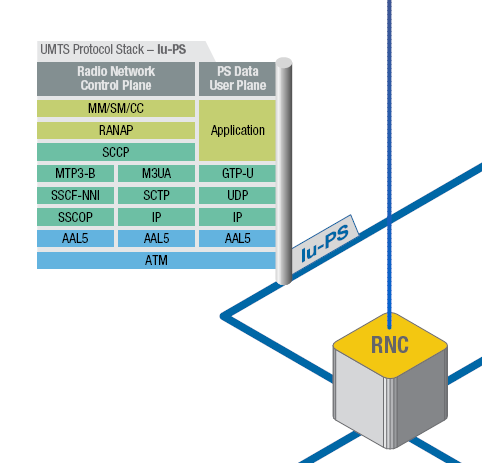
By the way, for the Gb interface there is also a separation of control and data planes, only they are not as strongly expressed as for the Iu-PS interface. The data transmission plane is shown in the diagram below:

The control plane over the Gb interface is depicted in the following diagram:

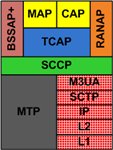
The interface between SGSN and HLR , which is very necessary for the operator’s packet network, since It is through it that the subscriber’s authentication and authorization procedures take place during the GPRS Attach procedures, or the Combined IMSI & GPRS Attach, as This interface is “pure” signaling, i.e. it is intended only for transmission of service information, it is based on the SS7 model, MAP is used as the main top-level protocol (see the diagram on the right), and to be precise, the special version is MAP-H.
This is the interface between SGSN and SMS-GMSC, i.e. The center for sending short messages, it is optional and optional, but introduces additional functionality in the packet network for sending short messages through packet channels. The protocol stack for this interface is no different from the stack on the Gr interface (between SGSN and HLR), since all the same procedures of the SS7 MAP protocol are used (see the protocol stack diagram for the Gr interface).
In more detail, the service of sending SMS through a packet network (SMS over GPRS) is discussed in the article “ Backup path for SMS . From myself I can add that the operators are not very willing to implement this interface and the service itself for sending messages through the packet network.
Another optional interface, between SGSN and EIR , allows you to check the legitimacy of using a mobile terminal subscriber by its IMEI code, performing queries to the database of IMEI codes (Gray, Black, White Lists) of the operator located in the databases of the network element EIR. The protocol stack is similar to the Gr, Gd interfaces — the MAP is used (see the diagram for the Gr interface) protocol, and to be precise, the MAP-E version.
The effectiveness of using IMEI codes is significantly increased if the central international database is used, or else the country should have its own internal IMEI code database to which all mobile operators will be connected, which is not always implemented in practice. Therefore, many operators use EIR platforms (to which requests for checking IMEI codes are made) of elements as mapping platforms for a pair of IMSI / MSISDN and IMEI values, i.e. in the case when the subscriber changes the SIM card or inserts it into another device - it automatically receives “caring” and not never annoying MMS / Internet / WAP / etc settings.
Another optional interface between SGSN and the MSC switch, which introduces the functionality of receiving and enabling CS (Circuit Services) services during an active GPRS / EDGE session. This is a pretty useful interface, because allows the subscriber to feel more comfortable, not bothering about their availability during an active GPRS / EDGE session. From my own experience I can say that unfortunately, if the operator’s network is built on equipment from different vendors, sometimes it is not always possible to combine the interface on both sides of the switch ( MSC ) and SGSN, therefore even in one operator’s network, there may be zones where You can implement the Gs interface, as well as those areas where this is not possible.
For more information on the possibility to make and receive calls during an active GPRS / EDGE session, I send readers to the GPRS article is not an obstacle to calls .
The interface through which billing data is transmitted for settlement operations with subscribers, it is implemented between SGSN and the billing platform - SCP. The CAP application of the SS7 model is used as the main protocol (see the diagram for the Gr interface).
Here I would like to make a small digression and tell how the process of settlements between the subscriber and the operator on the use of package services takes place. First, remember that there are two types of subscribers:
For pre-paid subscribers billing is carried out in real time, i.e. when raising (and also before activating) PDP Context from SGSN via Ge interface, a request is made via the CAP protocol for the IN platform ( SCP ) - the billing platform, about the current balance on the subscriber’s balance, and then (if there is a necessary balance on account) at certain intervals (timers that are set by the operator) repeated requests are made for the possible continuation of the active PDP session of the prepaid subscriber.
For post-paid subscribers, i.e. contract subscribers, billing of data is mainly collected at SGSN itself (although there are billing systems that collect data at GGSN), i.e. on SGSN for each subscriber so-called are generated. CDR files, which are then transferred via tftp / ftp protocol to billing systems and by which subscriber bills are calculated, although for post-paid subscribers there are also online billing systems, but they are not widely used by operators, at least this is the information for most operators in Ukraine.
Thus, the main difference between these two types of subscribers is that for pre-paid so-called. online billing, and for post-paid - offline billing.
In fact, the interface in its full implementation is now optional, since Many operators use the Ge interface for pre-paid subscribers, and CDR files for contract subscribers are generated on the SGSN itself, but nevertheless, using the Ga interface, it is possible to implement billing calculations on GGSN. In its true implementation, this interface connects SGSN or GGSN with CG [Charging Gateway] and in most implementations is a packet interface (TCP / IP) using the GTP `protocol as the top level (see diagram below).
By the way, if the network is built on the equipment of one vendor, i.e. SGSN / GGSN and CG are supplied by one vendor, the Ga interface can be used “to the full”, while it will be based on the vendor’s own proprietary developments, i.e. will be closed to the operator itself.
Two fairly similar interfaces that are needed to implement SGSN and GGSN connectivity. What does Gn use if the two network elements are in the same PLMN (en), and Gp - if the elements are in different PLMN, i.e. the subscriber uses GPRS / EDGE services in roaming.
The interfaces use two types of GTP protocol:
By the way, the Gp interface is not always necessary even if the subscriber is roaming, i.e. it is possible to refuse to use this interface if you fulfill several additional conditions (see the article Expensive GPRS Roaming ).
One of the simplest, but at the same time the most important interfaces for a packet network, since it is through him that the operator has access to external Internet / Intranet networks. Basically, the interface is fully packet (IP) and often represents a gigabit link to the routers of the mobile operator.
Here is such a list of the main interfaces of the GSN elements of the PS Core Network mobile operator.
A small assistant:
ATM - Asynchronous Transfer Mode
BSC - Base Station Controller
BSS - Base Station Subsystem
EIR - Equipment Identity Register
GGSN - Gateway GPRS Support Node
GPRS - General Packet Radio Service
GTP - GPRS Tunneling Protocol
HLR - Home Location Register
IMEI - International Mobile Equipment Identity
IMSI - International Mobile Subscriber Identity
MS - Mobile Station
MSC - Mobile Switching Center
MSISDN - Mobile Subscriber Integrated Services Digital Network Number
MT - Mobile Terminal
PCM - Pulse-Code modulation
PDN - Packet Data Network
PDP - Packet Data Protocol
PDU - Packet Data Unit
PLMN - Public Land Mobile Network
PS - Packet Switched
RNC - Radio Network Controller
SGSN - Serving GPRS Support Node
UMTS - Universal Mobile Telecommunications System
VLR - Visitor Location Register
Intro
The standard connection scheme of key GSN elements of a packet network, which is usually depicted in many textbooks and courses on the PS Core Network, looks like this:

To begin with, I would like to clarify that not all of the interfaces shown in the figure above are necessary for the provision of package services to the end subscriber — some of them are optional, i.e. These interfaces introduce additional functionality for the core network elements of the PS Core Network, while others are the basis for building any packet network and will be implemented anyway.
')
It should also be remembered that some interfaces are intended only for transmission of service signaling information, therefore they are implemented on the basis of the SS7 model stack, and various technologies can serve as a transport for them - PCM , IP, ATM (see diagram below).

In principle, there is now a tendency to switch to IP-based communication channels on all interfaces of the packet network, which is associated with their economic benefits, high prevalence, as well as the TCP / IP network’s “nature” abroad of SGSN’s abroad and general transitions to similar IMS systems based on packet technologies.
In order to have a more holistic picture of all the interfaces and stacks of packet network protocols for 2G / 3G network architectures, we turn to the interface circuitry from Tektronix :

Based on this scheme, we begin our acquaintance with the interfaces of GSN elements.
Gb interface
Using this interface, the base station controllers are connected directly to the SGSN. And in fact, the channels on the base station controller (BSC) are organized on special boards - PCU [Packet Control Unit], which process the packet data of subscribers. The interface can be implemented both on a fairly common scheme via PCM lines ( E1 streams), the user data of which will be “packed” in Frame Relay (FR) connections to the SGSN, and directly on one of the packet technologies - IP, for example.
The overall protocol stack on this interface is shown in the diagram below:

As we have already mentioned, recently there is a tendency to switch to more cost-effective and cheaper options for implementing network interfaces, so many vendors producing both base station controllers and SGSNs provide the ability to implement Gb interface based on IP transport, t . - Gb over IP.
At the same time, we should not forget that in the “pure” form of Gb the interface is implemented only for the 2G architecture, i.e. for the implementation of the interface between SGSN and the base station controller - BSC , and for 3G (UMTS), i.e. to implement the interface between the SGSN and the RNC (en) controller, the Iu-PS interface is used, and inside it there is a separation of signaling (control) planes - Control Plane (based on the GTP-C protocol) and subscriber data transfer planes - User Plane (based on GTP-U protocol).
The protocol stack of the Iu-PS interface is depicted in the diagram below:

By the way, for the Gb interface there is also a separation of control and data planes, only they are not as strongly expressed as for the Iu-PS interface. The data transmission plane is shown in the diagram below:

The control plane over the Gb interface is depicted in the following diagram:

Gr interface

The interface between SGSN and HLR , which is very necessary for the operator’s packet network, since It is through it that the subscriber’s authentication and authorization procedures take place during the GPRS Attach procedures, or the Combined IMSI & GPRS Attach, as This interface is “pure” signaling, i.e. it is intended only for transmission of service information, it is based on the SS7 model, MAP is used as the main top-level protocol (see the diagram on the right), and to be precise, the special version is MAP-H.
Gd interface
This is the interface between SGSN and SMS-GMSC, i.e. The center for sending short messages, it is optional and optional, but introduces additional functionality in the packet network for sending short messages through packet channels. The protocol stack for this interface is no different from the stack on the Gr interface (between SGSN and HLR), since all the same procedures of the SS7 MAP protocol are used (see the protocol stack diagram for the Gr interface).
In more detail, the service of sending SMS through a packet network (SMS over GPRS) is discussed in the article “ Backup path for SMS . From myself I can add that the operators are not very willing to implement this interface and the service itself for sending messages through the packet network.
Gf interface
Another optional interface, between SGSN and EIR , allows you to check the legitimacy of using a mobile terminal subscriber by its IMEI code, performing queries to the database of IMEI codes (Gray, Black, White Lists) of the operator located in the databases of the network element EIR. The protocol stack is similar to the Gr, Gd interfaces — the MAP is used (see the diagram for the Gr interface) protocol, and to be precise, the MAP-E version.
The effectiveness of using IMEI codes is significantly increased if the central international database is used, or else the country should have its own internal IMEI code database to which all mobile operators will be connected, which is not always implemented in practice. Therefore, many operators use EIR platforms (to which requests for checking IMEI codes are made) of elements as mapping platforms for a pair of IMSI / MSISDN and IMEI values, i.e. in the case when the subscriber changes the SIM card or inserts it into another device - it automatically receives “caring” and not never annoying MMS / Internet / WAP / etc settings.
Gs interface
Another optional interface between SGSN and the MSC switch, which introduces the functionality of receiving and enabling CS (Circuit Services) services during an active GPRS / EDGE session. This is a pretty useful interface, because allows the subscriber to feel more comfortable, not bothering about their availability during an active GPRS / EDGE session. From my own experience I can say that unfortunately, if the operator’s network is built on equipment from different vendors, sometimes it is not always possible to combine the interface on both sides of the switch ( MSC ) and SGSN, therefore even in one operator’s network, there may be zones where You can implement the Gs interface, as well as those areas where this is not possible.
For more information on the possibility to make and receive calls during an active GPRS / EDGE session, I send readers to the GPRS article is not an obstacle to calls .
Ge interface
The interface through which billing data is transmitted for settlement operations with subscribers, it is implemented between SGSN and the billing platform - SCP. The CAP application of the SS7 model is used as the main protocol (see the diagram for the Gr interface).
Here I would like to make a small digression and tell how the process of settlements between the subscriber and the operator on the use of package services takes place. First, remember that there are two types of subscribers:
- Pre-paid - prepaid subscribers
- Post-paid - contract subscribers
For pre-paid subscribers billing is carried out in real time, i.e. when raising (and also before activating) PDP Context from SGSN via Ge interface, a request is made via the CAP protocol for the IN platform ( SCP ) - the billing platform, about the current balance on the subscriber’s balance, and then (if there is a necessary balance on account) at certain intervals (timers that are set by the operator) repeated requests are made for the possible continuation of the active PDP session of the prepaid subscriber.
For post-paid subscribers, i.e. contract subscribers, billing of data is mainly collected at SGSN itself (although there are billing systems that collect data at GGSN), i.e. on SGSN for each subscriber so-called are generated. CDR files, which are then transferred via tftp / ftp protocol to billing systems and by which subscriber bills are calculated, although for post-paid subscribers there are also online billing systems, but they are not widely used by operators, at least this is the information for most operators in Ukraine.
Thus, the main difference between these two types of subscribers is that for pre-paid so-called. online billing, and for post-paid - offline billing.
Ga interface
In fact, the interface in its full implementation is now optional, since Many operators use the Ge interface for pre-paid subscribers, and CDR files for contract subscribers are generated on the SGSN itself, but nevertheless, using the Ga interface, it is possible to implement billing calculations on GGSN. In its true implementation, this interface connects SGSN or GGSN with CG [Charging Gateway] and in most implementations is a packet interface (TCP / IP) using the GTP `protocol as the top level (see diagram below).
By the way, if the network is built on the equipment of one vendor, i.e. SGSN / GGSN and CG are supplied by one vendor, the Ga interface can be used “to the full”, while it will be based on the vendor’s own proprietary developments, i.e. will be closed to the operator itself.
Gn, Gp interfaces
Two fairly similar interfaces that are needed to implement SGSN and GGSN connectivity. What does Gn use if the two network elements are in the same PLMN (en), and Gp - if the elements are in different PLMN, i.e. the subscriber uses GPRS / EDGE services in roaming.
The interfaces use two types of GTP protocol:
- GTP-U - to transfer user data
- GTP-C - for transmission of service information *
* - for example, when activating the PDP Context, the SGSN sends a PDP Context Activation request to the GGSN using the GTP-C protocol.
By the way, the Gp interface is not always necessary even if the subscriber is roaming, i.e. it is possible to refuse to use this interface if you fulfill several additional conditions (see the article Expensive GPRS Roaming ).
Gi interface
One of the simplest, but at the same time the most important interfaces for a packet network, since it is through him that the operator has access to external Internet / Intranet networks. Basically, the interface is fully packet (IP) and often represents a gigabit link to the routers of the mobile operator.
Here is such a list of the main interfaces of the GSN elements of the PS Core Network mobile operator.
A small assistant:
ATM - Asynchronous Transfer Mode
BSC - Base Station Controller
BSS - Base Station Subsystem
EIR - Equipment Identity Register
GGSN - Gateway GPRS Support Node
GPRS - General Packet Radio Service
GTP - GPRS Tunneling Protocol
HLR - Home Location Register
IMEI - International Mobile Equipment Identity
IMSI - International Mobile Subscriber Identity
MS - Mobile Station
MSC - Mobile Switching Center
MSISDN - Mobile Subscriber Integrated Services Digital Network Number
MT - Mobile Terminal
PCM - Pulse-Code modulation
PDN - Packet Data Network
PDP - Packet Data Protocol
PDU - Packet Data Unit
PLMN - Public Land Mobile Network
PS - Packet Switched
RNC - Radio Network Controller
SGSN - Serving GPRS Support Node
UMTS - Universal Mobile Telecommunications System
VLR - Visitor Location Register
Source: https://habr.com/ru/post/101213/
All Articles
